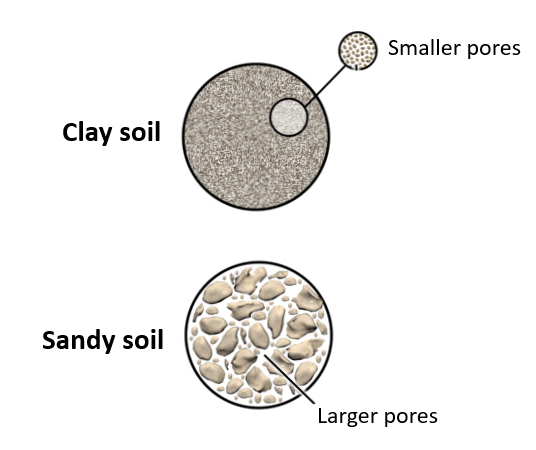
Water holding capacity of sandy soil as compared to clay soil is
(a)More
(b)Less
(c)Equal
(d)None of the above
Answer
573.9k+ views
Hint: The pore size is very small in the clay soil whereas the pore size is larger in the sandy soil in comparison to the clay soil. This creates a difference in water holding capacity.
Complete answer:
The composition of soil has the greatest effect on the capacity to retain water. Clays and clay loams have about twice the capacity of the sandy soils to retain water. That's because clayey soils have a much bigger proportion of water holding micropores compared to sands in terms of pore space.
Around half the volume of a soil is pore space filled by varying quantities of air and water, depending on how wet the soil is. Water is kept in the pore spaces in the form of films that adhere to the particles of the soil. The smaller soil pores are called micropores the larger are macropores. Macropores do not keep the water well because the water films become too dense to stick to the surrounding soil particles.
Water Drainage refers to the ability of soil to dispose of excess water through gravity by downward movement. Topography, density, filth, depth, and the presence of pans (compacted or cemented zones) affects it. Nearly all major crops require reasonably good drainage so their roots can get enough oxygen. Drainage of water occurs via the macropore. Water holding capacity is the ability of the soil to retain water and it occurs via the micropore.
Thus, the clay soil has a high water-holding capacity and less water drainage ability whereas the sandy soil has high water drainage capacity and less water holding capacity.

So, the correct answer is ‘less’.
Note: Clay soil has high water, nutrient content and will be poor in the oxygen content whereas, in sandy soil, the water and the nutrient content is low. Sandy loam or loamy soils are highly preferred for plant growth.
Complete answer:
The composition of soil has the greatest effect on the capacity to retain water. Clays and clay loams have about twice the capacity of the sandy soils to retain water. That's because clayey soils have a much bigger proportion of water holding micropores compared to sands in terms of pore space.
Around half the volume of a soil is pore space filled by varying quantities of air and water, depending on how wet the soil is. Water is kept in the pore spaces in the form of films that adhere to the particles of the soil. The smaller soil pores are called micropores the larger are macropores. Macropores do not keep the water well because the water films become too dense to stick to the surrounding soil particles.
Water Drainage refers to the ability of soil to dispose of excess water through gravity by downward movement. Topography, density, filth, depth, and the presence of pans (compacted or cemented zones) affects it. Nearly all major crops require reasonably good drainage so their roots can get enough oxygen. Drainage of water occurs via the macropore. Water holding capacity is the ability of the soil to retain water and it occurs via the micropore.
Thus, the clay soil has a high water-holding capacity and less water drainage ability whereas the sandy soil has high water drainage capacity and less water holding capacity.

So, the correct answer is ‘less’.
Note: Clay soil has high water, nutrient content and will be poor in the oxygen content whereas, in sandy soil, the water and the nutrient content is low. Sandy loam or loamy soils are highly preferred for plant growth.
Recently Updated Pages
Master Class 12 Business Studies: Engaging Questions & Answers for Success

Master Class 12 Economics: Engaging Questions & Answers for Success

Master Class 12 English: Engaging Questions & Answers for Success

Master Class 12 Maths: Engaging Questions & Answers for Success

Master Class 12 Social Science: Engaging Questions & Answers for Success

Master Class 12 Chemistry: Engaging Questions & Answers for Success

Trending doubts
What are the major means of transport Explain each class 12 social science CBSE

Which are the Top 10 Largest Countries of the World?

Draw a labelled sketch of the human eye class 12 physics CBSE

How much time does it take to bleed after eating p class 12 biology CBSE

Explain sex determination in humans with line diag class 12 biology CBSE

Differentiate between homogeneous and heterogeneous class 12 chemistry CBSE




